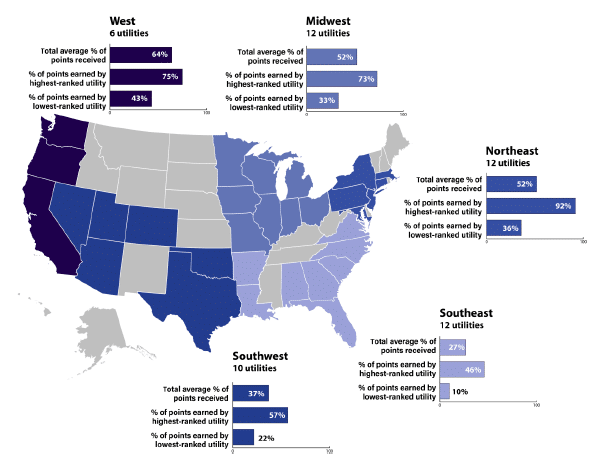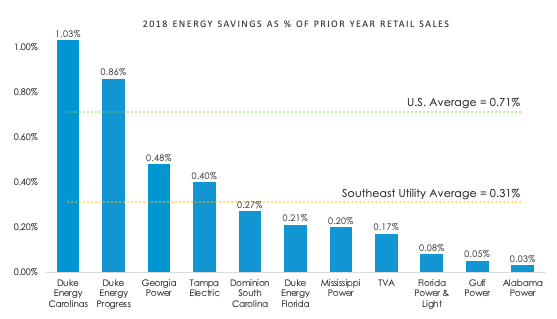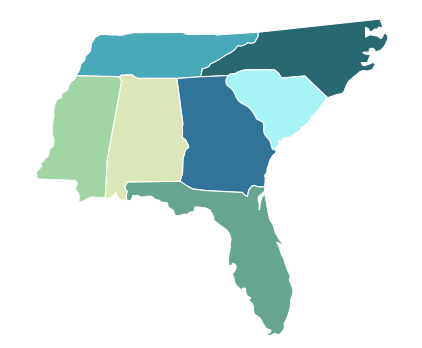SACE’s recently released Energy Efficiency in the Southeast 2019 Annual Report shows how the South trails far behind other regions of the country on annual energy efficiency savings. In fact, Duke in the Carolinas is the only utility in our region that is even within range of the national average, while most Southeastern utilities deliver embarrassingly low levels of efficiency savings for their customers.
ACEEE’s Analysis Adds Key Data Insights and a National Perspective
Since its founding in 1980, the American Council for an Energy Efficient Economy (ACEEE) has been an invaluable resource for insightful analysis and energy efficiency data across a broad range of subjects. To put efficiency into context, ACEEE’s research has identified overarching efficiency performance trends, economic impacts, policy solutions, case studies, and comparative benchmarks.
Last month, ACEEE released its 2020 Utility Energy Efficiency Scorecard, a comparative ranking of 52 major U.S. electric utility companies. The report provides valuable national context and data analysis that reveals what is – and what is not – working for efficiency in the region. ACEEE’s work adds to and reinforces key findings from SACE’s Energy Efficiency in the Southeast report, and includes some surprising results.
The Southeast Trails Far Behind Other Regions of the Country
Between 2015 and 2018, the 52 major utilities in ACEEE’s utility scorecard increased total efficiency savings by 20%. This is good news for efficiency at large, but it is critical to note that progress has been highly uneven across individual utilities.
Of the 52 utilities in ACEEE’s scorecard, eight were also included in SACE’s 2019 EE Annual Report:
- Duke Energy Carolinas*
- Duke Energy Progress
- Georgia Power
- SCE&G / DESC
- Tampa Electric
- Duke Energy Florida
- Florida Power & Light
- Alabama Power
*Note: ACEEE listed DEC separately for North and South Carolina
Like SACE, ACEEE revealed that utilities in the Southeast have captured only a fraction of the efficiency savings achieved in other parts of the country. Additionally, program structures and enabling policies for efficiency resources are far less developed in the Southeast than in other jurisdictions.

When all three of ACEEE’s evaluation criteria – Program Performance, Program Offerings, and Enabling Mechanisms – are added together, the Southeast as a region captured only 27% of available points. This is far short of the 64% and 52% of total points earned by the top two regions, the West and Midwest. Even more revealing, 7 out of the 10 worst performing utilities are located in the Southeast.
Laggards & Leaders: The Worst and Best Utilities in the Southeast
It comes as no surprise that Florida Power & Light and Alabama Power posted the worst scores for all 52 utilities in ACEEE’s ranking, followed closely by Duke Energy Florida, TECO, and SCE&G.
Alabama Power has no efficiency policies or programs to speak of, explaining its last in class ranking. Florida’s use of the deeply flawed Ratepayer Impact Measure test to eliminate nearly all cost-effective efficiency measures (no other state uses the RIM test in this way) helps explain why FP&L was ranked at the very bottom of the worst-performing utilities in the country.
By contrast, Duke Carolinas, Duke Progress, and Georgia Power each performed better. These utilities have more rigorous Commission oversight, more active stakeholder engagement, and receive generous financial incentives for higher efficiency performance. In the past year, utility regulators in North Carolina and Georgia have placed additional energy efficiency requirements on Duke and Georgia Power for their future integrated resource planning proceedings, which will be something to watch in the coming years.
Surprising Results
We were most surprised by ACEEE’s relatively low ranking of Duke Energy Progress (DEP) compared to the results in SACE’s own Energy Efficiency in the Southeast Annual Report. In SACE’s report, DEP’s efficiency savings as a percentage of annual sales gave them a substantial lead over all non-Duke utilities in the Southeast. This advantage was largely blunted by the wide range of additional metrics ACEEE tracked in their utility scorecard.

As a result, DEP trailed far behind sister company Duke Energy Carolinas (DEC) and was much closer to Georgia Power and the Florida utilities on the ACEEE scorecard than we would have expected. While DEP had more than 50% higher annual energy savings than Georgia Power, its scoring by ACEEE was only half a point higher for this metric and accounted for only about 10% of the final score. In other words, this key metric in SACE’s analysis was largely lost in the wash when combined with the 19 other metrics in ACEEE’s ranking system.
Flip Side of the Coin
ACEEE notes that “energy efficiency [is] a particularly valuable tool for greenhouse gas reduction…especially in the Southeast, where there is the most potential for energy efficiency growth based on performance in the Scorecard.” Relatively low historic efficiency performance by Southeastern utilities actually presents a real opportunity, should additional steps be taken to capitalize on the region’s untapped efficiency potential in the future. Put another way, from this far down, the only way to go is up!
ACEEE’s 2020 Utility Scorecard reported on the following measures: Annual efficiency savings, annual spending, lifetime savings, performance compared to savings target, residential energy assessments, cost effectiveness, portfolio comprehensiveness, emerging areas, low income programs, electric vehicles, advanced metering, data access, energy savings targets, customer charge, demand charges, time of use, utility business model, EM&V, and resource planning.
This blog is Part 4 in the series following the release of the Energy Efficiency in the Southeast 2019 Annual Report. To learn more about the findings of the report:
- Read Part 1 of the series giving an overview of the report: “Energy Efficiency in the Southeast” 2019 Annual Report.
- Read Part 2 of the series showcasing regional leadership by North Carolina and Duke Energy: “North Carolina and Duke Energy Hold Commanding Lead on Energy Efficiency in the Southeast“
- Read Part 3 of this series on the relationship between energy efficiency and integrated resource planning in Mississippi: “Efficiency in Mississippi: Utilities Can Do More, Customers Deserve No Less.“
- Watch a webinar where SACE technical staff discusses report findings.
- Additional blogs related to energy efficiency in the Southeast here.
#EEinSE2019



